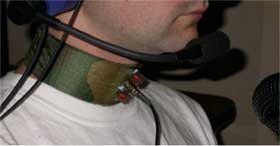DARPA is working on the Advanced Speech Encoding project, aimed at replacing microphones with non-acoustic sensors that detect speech via nerve and muscle activity, rather than sound itself.
One system, developed by Rick Brown of Worcester Polytechnic Institute, relies on a sensor worn around the neck called a tuned electromagnetic resonator collar (TERC). The collar detects changes in capacitance caused by movement of the vocal cords, and would allow speech to be heard above loud background noise.

Another approach involves placing electrodes on the neck, to detect changes in impedance during speech. A neural network processes the data and identifies the pattern of words. The sensor can even detect subvocal or silent speech. The speech pattern is sent to a computerised voice generator that recreates the words.
The technology could be used by soldiers on covert missions, in noisy vehicles or working underwater.
But one day we might use it to be heard over the din of a factory or a loud bar. Or even to use phones in libraries without disturbing others. Brown has produced a TERC prototype, and an electromyographic prototype is expected in 2008.
Via New Scientist. Picture from PDF of the project.







